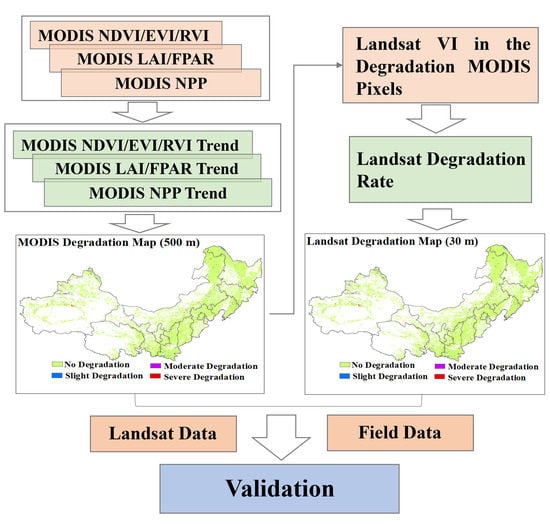Detecting Forest Degradation in the Three-North Forest Shelterbelt in China from Multi-Scale Satellite Images
Abstract
1. Introduction
2. Materials and Methods
2.1. Study Area
2.2. Data and Data Processing
2.2.1. Remote Sensing Data
2.2.2. Field Data
2.3. Methods
2.3.1. Indicators to Describe Forest Degradation
2.3.2. Methods to Detect Forest Degradation from Remote Sensing Data
- Analysis of the Time Series Indicators from MODIS Products
- Degradation Rate from Landsat Data
- Validation of the Results
3. Results
3.1. Forest Degradation Maps in the Three-North Forest Shelterbelt
3.1.1. Trends of the Indicators from 2000 to 2010
3.1.2. Forest Degradation Maps from MODIS and Landsat ETM+ Data
3.1.3. High Resolution (30 m) Forest Degradation Maps in Typical Areas
3.2. Validation of the Degradation Areas and Degradation Level
3.2.1. Validation with Ground Survey Data
3.2.2. Cross Validation with High Resolution Data
4. Discussion
4.1. Criteria and Indicators for Forest Degradation Detection from Remote Sensing
4.2. Influence of Climate Map on Accuracy of Forest Degradation Detection
4.3. Uncertainly Analysis
4.4. Limitations and Future Work
5. Conclusions
Supplementary Materials
Author Contributions
Funding
Data Availability Statement
Acknowledgments
Conflicts of Interest
References
- Bewernick, T. Mapping Forest Degradation in the Mau Forest Complex Using NDFI Time Series; Wageningen University: Wageningen, The Netherlands, 2016. [Google Scholar]
- Bullock, E.L.; Woodcock, C.E.; Olofsson, P. Monitoring tropical forest degradation using spectral unmixing and Landsat time series analysis. Remote Sens. Environ. 2020, 238, 110968. [Google Scholar] [CrossRef]
- Grinand, C.; Rakotomalala, F.; Gond, V.; Vaudry, R.; Bernoux, M.; Vieilledent, G. Estimating deforestation in tropical humid and dry forests in Madagascar from 2000 to 2010 using multi-date Landsat satellite images and the random forests classifier. Remote Sens. Environ. 2013, 139, 68–80. [Google Scholar] [CrossRef]
- Cui, T.; Sun, R.; Xiao, Z.; Liang, Z.; Wang, J. Simulating spatially distributed solar-induced chlorophyll fluorescence using a BEPS-SCOPE coupling framework. Agric. For. Meteorol. 2020, 295, 108169. [Google Scholar] [CrossRef]
- Berenguer, E.; Ferreira, J.; Gardner, T.A.; Aragão, L.E.O.C.; De Camargo, P.B.; Cerri, C.E.; Durigan, M.; De Oliveira, R.C.; Vieira, I.C.G.; Barlow, J. A large-scale field assessment of carbon stocks in human-modified tropical forests. Glob. Chang. Biol. 2014, 20, 3713–3726. [Google Scholar] [CrossRef] [PubMed]
- Baccini, A.; Walker, W.; Carvalho, L.; Farina, M.; Sulla-Menashe, D.; Houghton, R.A. Tropical forests are a net carbon source based on aboveground measurements of gain and loss. Science 2017, 358, 230–234. [Google Scholar] [CrossRef]
- Pearson, T.R.; Brown, S.; Murray, L.; Sidman, G. Greenhouse gas emissions from tropical forest degradation: An underestimated source. Carbon Balance Manag. 2017, 12, 1–11. [Google Scholar] [CrossRef] [PubMed]
- Bradley, B.A.; Jacob, R.W.; Hermance, J.F.; Mustard, J.F. A curve fitting procedure to derive inter-annual phenologies from time series of noisy satellite NDVI data. Remote Sens. Environ. 2007, 106, 137–145. [Google Scholar] [CrossRef]
- Lunetta, R.S.; Knight, J.F.; Ediriwickrema, J.; Lyon, J.G.; Worthy, L.D. Land-cover change detection using multi-temporal MODIS NDVI data. Remote Sens. Environ. 2006, 105, 142–154. [Google Scholar] [CrossRef]
- Spruce, J.P.; Sader, S.; Ryan, R.E.; Smoot, J.; Kuper, P.; Ross, K.; Pradose, D.; Russellf, J.; Gasserg, G.; McKelliph, R.; et al. Assessment of MODIS NDVI time series data products for detecting forest defoliation by gypsy moth outbreaks. Remote Sens. Environ. 2011, 115, 427–437. [Google Scholar] [CrossRef]
- Souza, C.M., Jr.; Siqueira, J.V.; Sales, M.H.; Fonseca, A.V.; Ribeiro, J.G.; Numata, I.; Cochrane, M.A.; Barber, C.P.; Roberts, D.A.; Barlow, J. Ten-year Landsat classification of deforestation and forest degradation in the Brazilian Amazon. Remote Sens. 2013, 5, 5493–5513. [Google Scholar] [CrossRef]
- Romero-Sanchez, M.E.; Ponce-Hernandez, R. Assessing and monitoring forest degradation in a deciduous tropical forest in Mexico via remote sensing indicators. Forests 2017, 8, 302. [Google Scholar] [CrossRef]
- Wang, C.; Qi, J.; Cochrane, M. Assessment of tropical forest degradation with canopy fractional cover from Landsat ETM+ and IKONOS imagery. Earth Interact. 2005, 9, 1–18. [Google Scholar] [CrossRef]
- Wang, H.; Pu, R.; Zhu, Q.; Ren, L.; Zhang, Z. Mapping health levels of Robinia pseudoacacia forests in the Yellow River delta, China, using IKONOS and Landsat 8 OLI imagery. Int. J. Remote Sens. 2015, 36, 1114–1135. [Google Scholar] [CrossRef]
- Hamunyela, E. Space-Time Monitoring of Tropical Forest Changes USING Observations from Multiple Satellites. Ph.D. Thesis, Wageningen University & Research, Laboratory of Geo-Information Science and Remote Sensing, Wageningen, The Netherlands, 2017. [Google Scholar]
- Lee, S.H.; Cho, H.K. Detection of the pine trees damaged by pine wilt disease using high spatial remote sensing data. In Proceedings of the ISPRS Commission VII Symposium “Remote Sensing: From Pixels to Processes”, Enschede, The Netherlands, 8–11 May 2006. [Google Scholar]
- Lambert, J.; Drenou, C.; Denux, J.P.; Balent, G.; Cheret, V. Monitoring forest decline through remote sensing time series analysis. GISci. Remote Sens. 2013, 50, 437–457. [Google Scholar] [CrossRef]
- Ogaya, R.; Barbeta, A.; Başnou, C.; Peñuelas, J. Satellite data as indicators of tree biomass growth and forest dieback in a Mediterranean holm oak forest. Ann. Forest Sci. 2015, 72, 135–144. [Google Scholar] [CrossRef]
- Wang, C.; Lu, Z.; Haithcoat, T.L. Using landsat images to detect oak decline in the Mark Twain national forest, Ozark highlands. For. Ecol. Manag. 2007, 240, 70–78. [Google Scholar] [CrossRef]
- Skakun, R.S.; Wulder, M.A.; Franklin, S.E. Sensitivity of the thematic mapper enhanced wetness difference index to detect mountain pine beetle red-attack damage. Remote Sens. Environ. 2003, 86, 433–443. [Google Scholar] [CrossRef]
- Hashim, M.; Pour, A.B.; Wei, C.K. Comparison of ETM+ and MODIS data for tropical forest degradation monitoring in the Peninsular Malaysia. J. Indian Soc. Remote. 2014, 42, 383–396. [Google Scholar] [CrossRef]
- Mitchell, A.L.; Rosenqvist, A.; Mora, B. Current remote sensing approaches to monitoring forest degradation in support of countries measurement, reporting and verification (MRV) systems for REDD+. Carbon Balance Manag. 2017, 12, 1–22. [Google Scholar] [CrossRef] [PubMed]
- Haywood, A.; Stone, C. Mapping eucalypt forest susceptible to dieback associated with bell miners (Manorina melanophys) using laser scanning, SPOT 5 and ancillary topographical data. Ecol. Model. 2011, 222, 1174–1184. [Google Scholar] [CrossRef]
- Wang, H.; Zhao, Y.; Pu, R.; Zhang, Z. Mapping Robinia pseudoacacia forest health conditions by using combined spectral, spatial, and textural information extracted from IKONOS imagery and random forest classifier. Remote Sens. 2015, 7, 9020–9044. [Google Scholar] [CrossRef]
- Zhu, J.; Zheng, X.; Wang, G.; Wu, B.; Liu, S.; Yan, C.; Li, Y.; Sun, Y.; Yan, Q.; Zeng, Y.; et al. Assessment of the world largest afforestation program: Success, failure, and future directions. BioRxiv 2017, 10, 105619. [Google Scholar]
- Li, M.; Liu, A.; Zou, C.; Xu, W.; Shimizu, H.; Wang, K. An overview of the “Three-North” Shelterbelt project in China. For. Stud. China 2012, 14, 70–79. [Google Scholar] [CrossRef]
- Ramon Solano, R.; Didan, K.; Jacobson, A.; Huete, A. Modis Vegetation Index User’s Guide; The University of Arizona: Tucson, AZ, USA, 2010. [Google Scholar]
- MODIS Vegetation Index Products. Available online: https://modis.gsfc.nasa.gov/data/dataprod/mod13.php (accessed on 5 January 2021).
- MODIS Leaf Area Index/FPAR Products. Available online: https://modis.gsfc.nasa.gov/data/dataprod/mod15.php (accessed on 5 January 2021).
- Knyazikhin, Y.; Glassy, J.; Privette, J.L.; Tian, Y.; Lotsch, A.; Zhang, Y.; Wang, Y.; Morisette, J.T.; Votava, T.; Myneni, R.B.; et al. MODIS Leaf Area Index (LAI) and Fraction of Photosynthetically Active Radiation Absorbed by Vegetation (FPAR) Product (MOD15) Algorithm Theoretical Basis Document. 1999. Available online: http://eospso.gsfc.nasa.gov/atbd/modistables.html (accessed on 5 January 2021).
- MODIS GPP/NPP Products. Available online: https://modis.gsfc.nasa.gov/data/dataprod/mod17.php (accessed on 5 January 2021).
- Running, S.W.; Zhao, M.S. User’s Guide. Daily GPP and Annual NPP (MOD17A2/A3) Products NASA Earth Observing SystemMODIS Land Algorithm. Version 3.0 for Collection 6. 2015. Available online: https://lpdaac.usgs.gov/sites/default/files/public/product_documentation/mod17_user_guide.pdf (accessed on 5 January 2021).
- United States Geological Survey. Available online: https://earthexplorer.usgs.gov (accessed on 5 January 2021).
- Beck, H.E.; Zimmermann, N.E.; Mcvicar, T.R.; Vergopolan, N.; Wood, E.F. Present and future kppen-geiger climate classification maps at 1-km resolution. Sci. Data 2018, 5, 180214. [Google Scholar] [CrossRef] [PubMed]
- National Forestry and Grassland Administration of China. Technical Regulation for the Restoration of Degraded Protective Forest (LY/T 3179—2020); NFGA: Beijing, China, 2020.
- Keith, H.; Mackey, B.; Berry, S.; Lindenmayer, D.; Gibbons, P. Estimating carbon carrying capacity in natural forest ecosystems across heterogeneous landscapes: Addressing sources of error. Glob. Chang. Biol. 2010, 16, 2971–2989. [Google Scholar] [CrossRef]
- Puyravaud, J.P. Standardising the calculation of the annual rate of deforestation. Forest Ecol. Manag. 2003, 177, 593–596. [Google Scholar] [CrossRef]
- Gupta, R.K.; Prasad, S.; Nadham, T.S.V.; Rao, G.H. Relative sensitivity of district mean RVI and NDVI over an agrometeorological zone. Adv. Space Res. 1993, 13, 261–264. [Google Scholar] [CrossRef]
- Huete, A.; Didan, K.; Miura, T.; Rodriguez, E.P.; Gao, X.; Ferreira, L.G. Overview of the radiometric and biophysical performance of the MODIS vegetation indices. Remote Sens. Environ. 2002, 83, 195–213. [Google Scholar] [CrossRef]
- Wang, Q.; Adiku, S.; Tenhunen, J.; André, G. On the relationship of ndvi with leaf area index in a deciduous forest site. Remote Sens. Environ. 2005, 94, 244–255. [Google Scholar] [CrossRef]
- Fensholt, R.; Sandholt, I.; Rasmussen, M.S. Evaluation of MODIS LAI, FAPAR and the relation between FAPAR and NDVI in a semi-arid environment using in situ measurements. Remote Sens. Environ. 2004, 91, 490–507. [Google Scholar] [CrossRef]
- Turner, D.P.; Ritts, W.D.; Cohen, W.B.; Gower, S.T.; Running, S.W.; Zhao, M.; Costa, M.H.; Kirschbaum, A.A.; Ham, J.M.; Saleska, S.R.; et al. Evaluation of MODIS NPP and GPP products across multiple biomes. Remote Sens. Environ. 2006, 102, 282–292. [Google Scholar] [CrossRef]
- Thompson, I.D.; Guariguata, M.R.; Okabe, K.; Bahamondez, C.; Nasi, R.; Heymell, V.; Sabogal, C. An operational framework for defining and monitoring forest degradation. Ecol. Soc. 2013, 18, 18. [Google Scholar] [CrossRef]
- Eckert, S.; Hüsler, F.; Liniger, H.; Hodel, E. Trend analysis of MODIS NDVI time series for detecting land degradation and regeneration in Mongolia. J. Arid Environ. 2015, 113, 16–28. [Google Scholar] [CrossRef]
- Verbesselt, J.; Hyndman, R.; Newnham, G.; Culvenor, D. Detecting trend and seasonal changes in satellite image time series. Remote Sens. Environ. 2010, 114, 106–115. [Google Scholar] [CrossRef]
- Jamali, S.; Jönsson, P.; Eklundh, L.; Ardö, J.; Seaquist, J. Detecting changes in vegetation trends using time series segmentation. Remote Sens. Environ. 2015, 156, 182–195. [Google Scholar] [CrossRef]
- Franke, J.; Navratil, P.; Keuck, V.; Peterson, K.; Siegert, F. Monitoring fire and selective logging activities in tropical peat swamp forests. IEEE J. Sel. Top. Appl. Earth Obs. Remote Sens. 2012, 5, 1811–1820. [Google Scholar] [CrossRef]
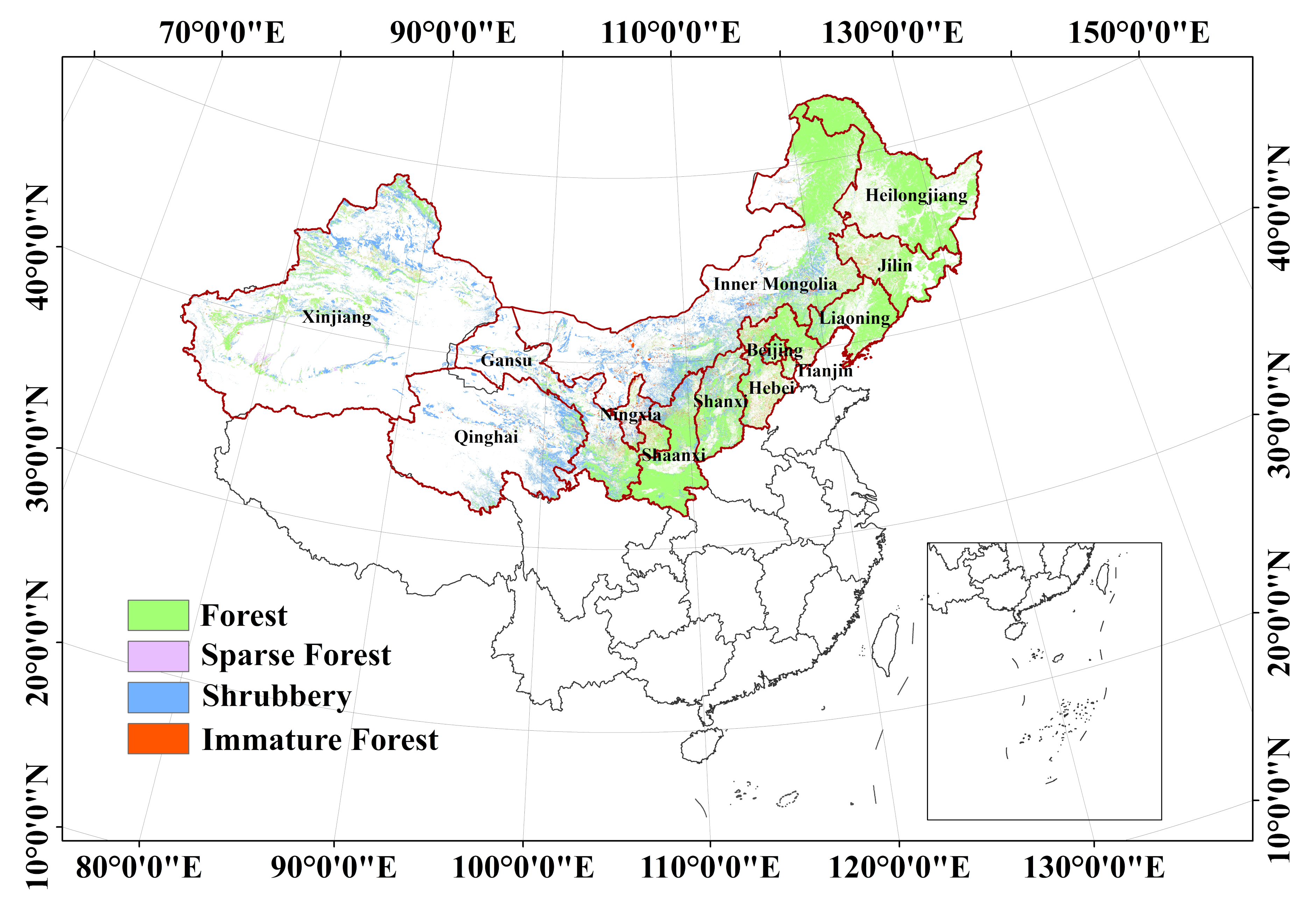

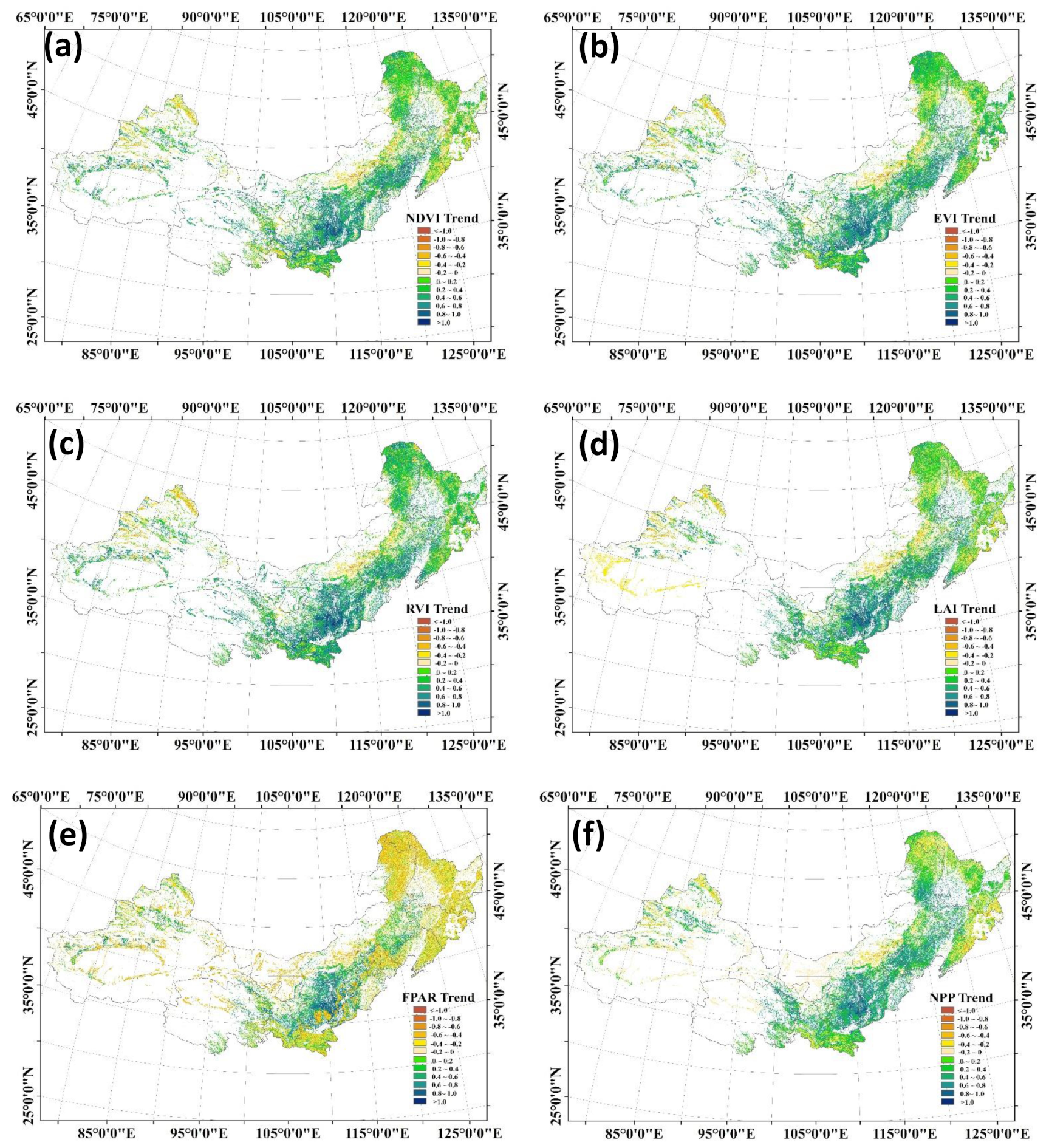

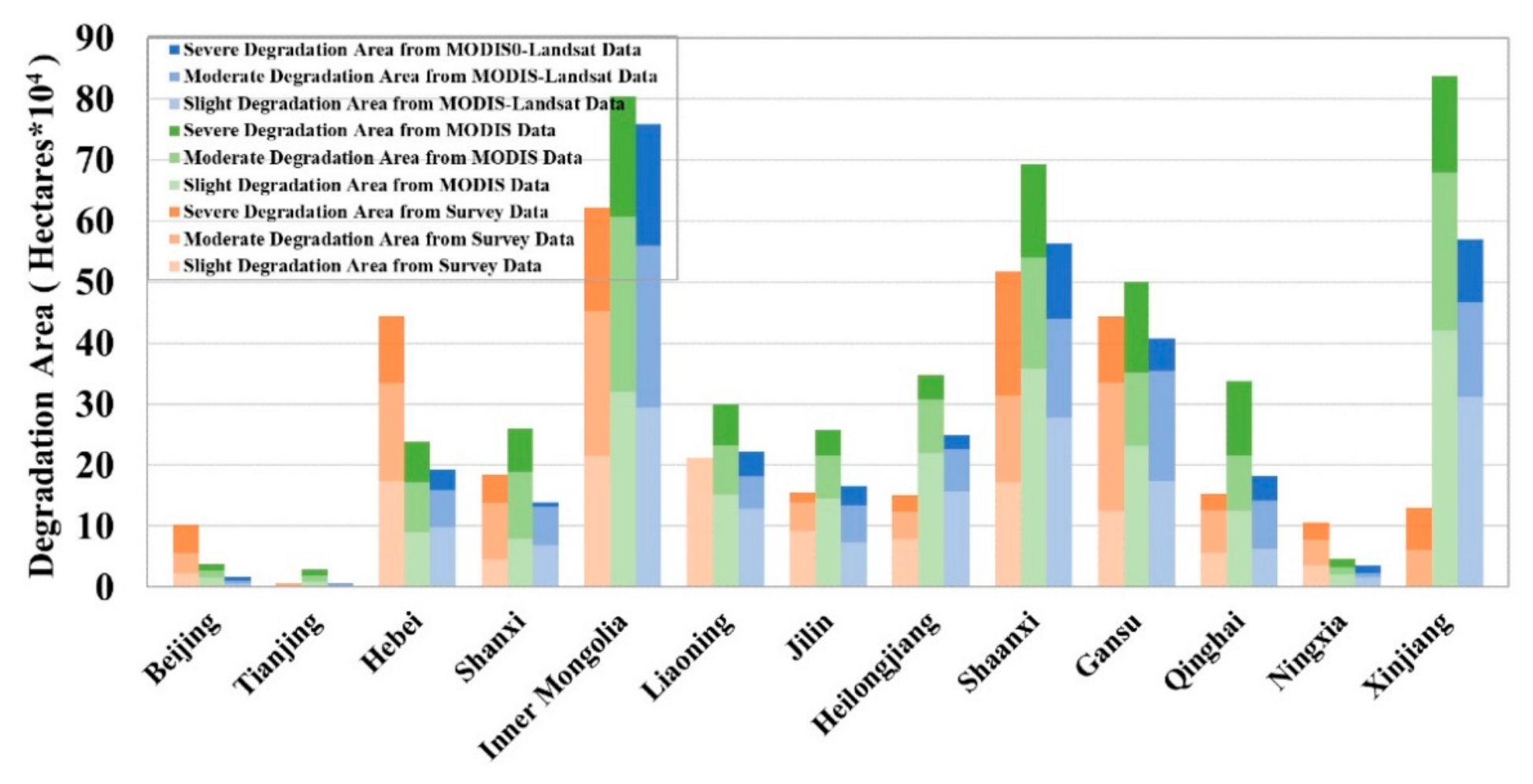
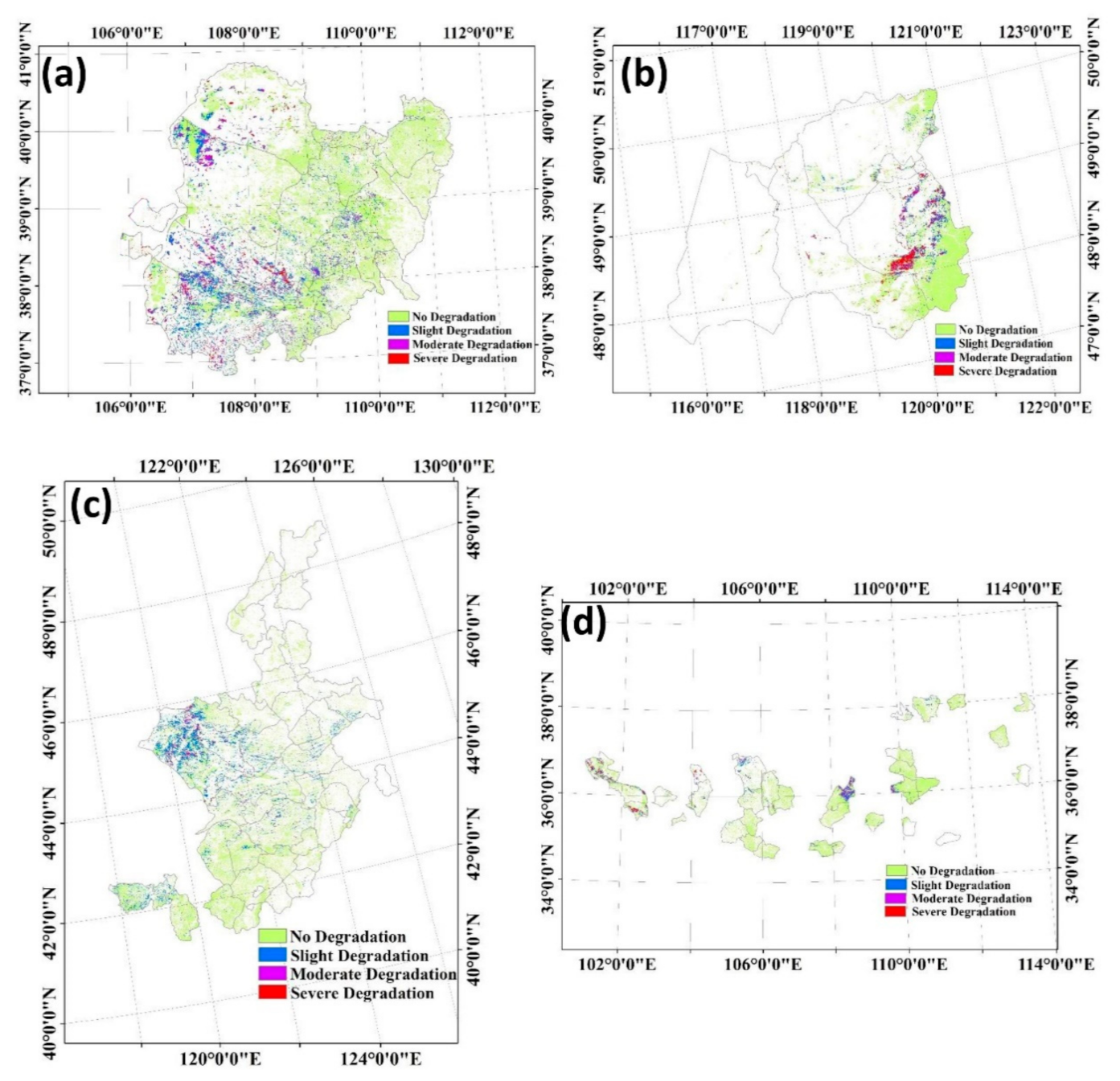
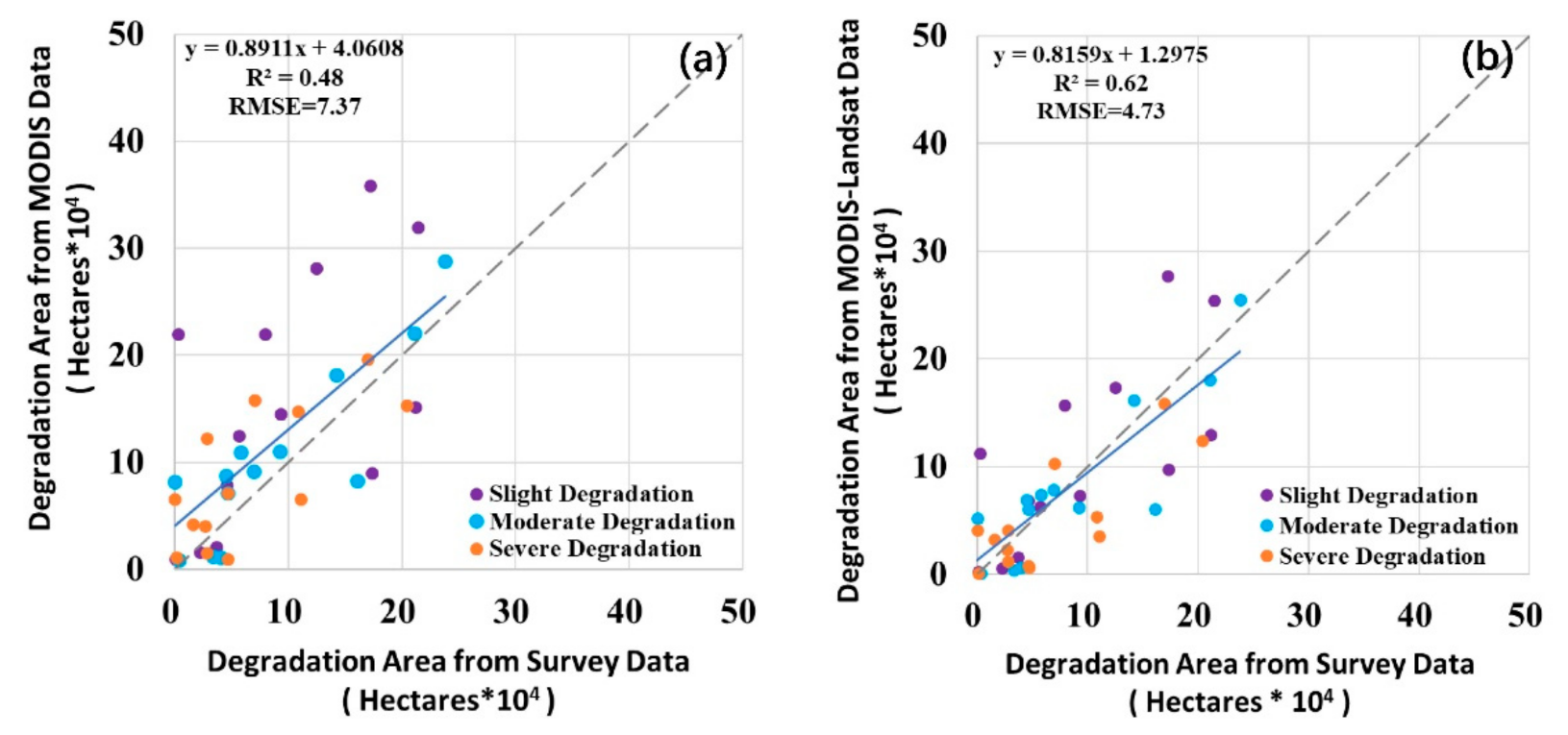
| Mean Producer’s Accuracy(%) | Mean User’s Accuracy(%) | Overall Accuracy(%) | Kappa Coefficient | |
|---|---|---|---|---|
| Maowusu | 80.74 | 80.13 | 80.64 | 0.77 |
| Hulun Buir | 84.89 | 85.45 | 83.32 | 0.80 |
| Khorchin | 82.55 | 78.74 | 80.22 | 0.81 |
| Loess Plateau | 81.54 | 76.55 | 77.41 | 0.76 |
| Average | 82.43 | 80.22 | 80.40 | 0.79 |
| Mean Producer’s Accuracy(%) | Mean User’s Accuracy(%) | Overall Accuracy(%) | Kappa Coefficient | |
|---|---|---|---|---|
| Maowusu | 88.54 | 80.63 | 84.78 | 0.81 |
| Hulun Buir | 79.37 | 88.54 | 86.47 | 0.83 |
| Khorchin | 86.23 | 83.55 | 83.50 | 0.85 |
| Loess Plateau | 83.10 | 79.65 | 82.65 | 0.80 |
| Average | 84.32 | 83.09 | 84.35 | 0.82 |
| Criterion | Indicators | Data | Validation Data | Accuracy | Reference |
|---|---|---|---|---|---|
| Carbon storage and Production | NPP, AGB | Landsat ETM+ | Imagery from Google Earth, Forest Inventory Sampling Plots | R2: 0.48~0.90 | [12] |
| Biodiversity | CFC | Landsat ETM+ | IKONOS | R2: 0.80 | [13] |
| MODIS, Landsat TM | Field data, MODIS Evapotranspiration | R2: 0.704~0.843 | [21] | ||
| Vitality | NDVI | MODIS, | Landsat TM, in-situ obervations | [44] | |
| NDFI | Landsat ETM+/OLI | Field data | User accuracy: 84.31%, Producer accuracy: 56.58% | [1] | |
| Landsat ETM+/OLI | Field data | User accuracy: 88.00%, Producer accuracy: 68.10% | [2] | ||
| Landsat ETM+ | Spot | User accuracy: 82.00% | [11] |
Publisher’s Note: MDPI stays neutral with regard to jurisdictional claims in published maps and institutional affiliations. |
© 2021 by the authors. Licensee MDPI, Basel, Switzerland. This article is an open access article distributed under the terms and conditions of the Creative Commons Attribution (CC BY) license (http://creativecommons.org/licenses/by/4.0/).
Share and Cite
Yu, T.; Liu, P.; Zhang, Q.; Ren, Y.; Yao, J. Detecting Forest Degradation in the Three-North Forest Shelterbelt in China from Multi-Scale Satellite Images. Remote Sens. 2021, 13, 1131. https://doi.org/10.3390/rs13061131
Yu T, Liu P, Zhang Q, Ren Y, Yao J. Detecting Forest Degradation in the Three-North Forest Shelterbelt in China from Multi-Scale Satellite Images. Remote Sensing. 2021; 13(6):1131. https://doi.org/10.3390/rs13061131
Chicago/Turabian StyleYu, Tao, Pengju Liu, Qiang Zhang, Yi Ren, and Jingning Yao. 2021. "Detecting Forest Degradation in the Three-North Forest Shelterbelt in China from Multi-Scale Satellite Images" Remote Sensing 13, no. 6: 1131. https://doi.org/10.3390/rs13061131
APA StyleYu, T., Liu, P., Zhang, Q., Ren, Y., & Yao, J. (2021). Detecting Forest Degradation in the Three-North Forest Shelterbelt in China from Multi-Scale Satellite Images. Remote Sensing, 13(6), 1131. https://doi.org/10.3390/rs13061131





